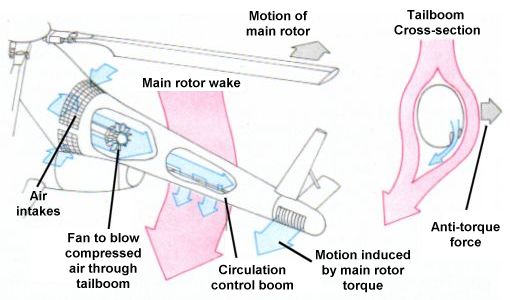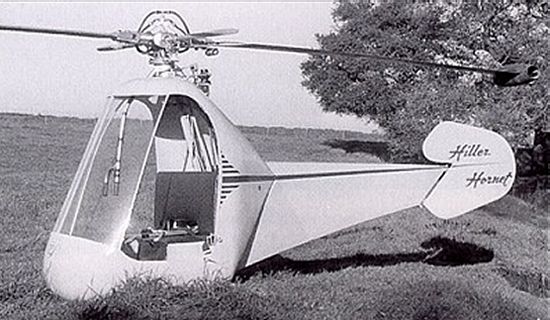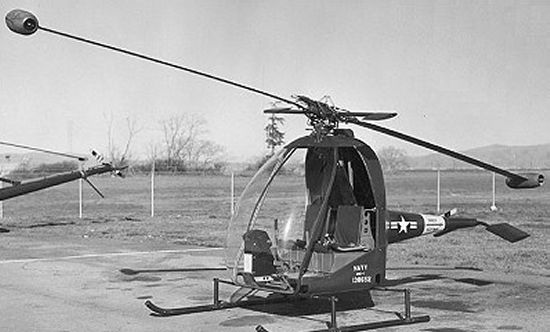|
||||||||||
|
|
||||||||||
|
||||||||||
|
|
||||||||||

NOTAR is a more recent and high-tech approach to solving the same problem. In this case, however, compressed air is forced out of slots inside the tail boom. This jet of air changes the behavior of the air flow in the vicinity of the tail boom in order to create an aerodynamic force that opposes the spinning torque motion.

That brings us to your question--a helicopter with a single rotor and no method of counteracting torque. Can such a vehicle exist? The answer is yes, but how can such a helicopter hope to overcome the effect of torque? Simply put, the torque does not exist!
The reason helicopters suffer the torque effect in the first place is that the engine is located in the fuselage. As the fuselage/engine spins the rotor, conservation of angular momentum tells us that the fuselage must spin as a result. Some method, like a tail rotor, has to be used to overcome that effect. However, what if the engine was instead mounted on the rotor itself? Now there is no mechanical interaction between the rotor and fuselage, so there is no torque effect.
It is this technique to which you are referring in your question. Your comment about the rotor being powered by jets refers to the fact that jet engines are actually located on the rotors rather than within the fuselage of the helicopter. One of the earliest examples of this design approach is the Hiller HJ-1 Hornet pictured below. Note the large cylindrical object on the tip of the rotor blade. This item is a jet engine, the thrust of which is used to spin the rotor. This approach is often referred to as the "tip-jet."

The Hornet was envisioned as a helicopter for the common man. It did away with the expensive engines, tail rotors, complex instrument panels, and gearboxes of conventional helicopters, instead relying on two ramjets mounted to the tips of the rotor blades for propulsion. A ramjet is the simplest member of the turbojet family since it has no moving parts and requires very little maintenance. Yaw control was provided by a conventional aircraft-style rudder, mounted at the end of the tail boom, designed to deflect the downwash off the rotor. The small helicopter first flew in 1950, and Hiller considered selling them for as little as $5,000 each. While the machine did have its drawbacks, including a noisy interior and short range, the concept was abandoned primarily because Hiller needed to focus its resources on providing military helicopters for the Korean War.

The Navy also showed interest in the tip-jet concept since it would eliminate the safety dangers associated with operating tail rotors from the cramped confines of a ship. A new helicopter called the HOE-1 was built for evaluation by the service and by NASA. The Army also tested the aircraft as the H-32. Unfortunately, the HOE-1/H-32 suffered numerous development difficulties and was deemed unacceptable for military use. Among the problems was the design's poor autorotation behavior. Autorotation is one of the principal safety features of a helicopter. During an engine failure, autorotation allows a pilot to use the spinning motion of the rotor blades to generate lift and glide to a safe emergency landing. Unfortunately, the large ramjet engine pods created enormous drag that slowed the spinning motion of the rotor and caused the helicopter to descend at nearly twice the rate of a normal helicopter. While a skilled pilot could compensate for the effect to make a safe landing, it was a definite drawback when compared to conventional helicopters.
Nevertheless, Hiller's concept continued to receive attention into the late 1960s. Many proposals revolved around flying cranes that could be used to lift enormous loads. One of the most ambitious designs was for a helicopter with a rotor diameter of over 325 ft (100 m) that could recover burned-out first stages of Saturn V rockets for reuse by NASA. Most of these concepts would have used turbojet engines mounted at the rotor tips. Some early designs, however, made use of a concept called the hot-cycle pressure-jet rotor. This design made use of hot gases that would be ducted through the blades themselves and exhausted through the blade tips. Performance was further enhanced by combusting fuel in the nozzle at the blade tip, a practice called tip-burning. Unfortunately, the pressure-jet was found to be much less efficient than the use of jets mounted at the rotor tips.

In addition to Hiller, the other great proponent of jet-powered rotors was Sud-Ouest in France, later known as Aerospatiale and Eurocopter. The most successful of its designs was the Djinn, shown below.

Unlike the approaches pursued by Hiller, the Djinn made use of a cold-jet strategy to spin the rotor. In this technique, compressed bleed air from the aircraft's gas turbine engines was ducted through channels inside the rotor blades and exhausted through nozzles at the blade tips to spin the rotor. This method eliminated the torque effect and the need for a tail rotor, so yaw control was provided by a large rudder at the end of a tail boom. The Djinn was perhaps the only "tip-jet" style helicopter to actually enter service. About 180 were built in the late 1950s and early 1960s, most for the French Army. A large number also found their way into the civil agricultural market where they were equipped with tanks and spray bars for spreading fertilizers or pesticides.
Though the concepts pioneered by Hiller in the US and Sud-Ouest in Europe offered promise in simplifying helicopter
design, they never proved to be very successful. In addition to autorotation problems, the tip-jet design required
rotor blades to be made stronger and heavier than conventional blades in order to support the heavy engines mounted
on the tips. Both the hot-cycle and cold-jet techniques also proved to be less efficient than more typical
helicopter designs. As a result, tip-jets have not resulted in good enough performance to justify replacing the
tail rotor, so the idea has never become a truly commercial success in production helicopters.
- answer by Jeff Scott, 14 September 2003
Related Topics:
Read More Articles:


|
Aircraft | Design | Ask Us | Shop | Search |

|
|
| About Us | Contact Us | Copyright © 1997- | |||
|
|
|||